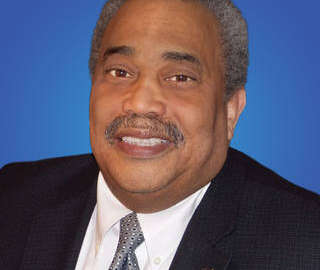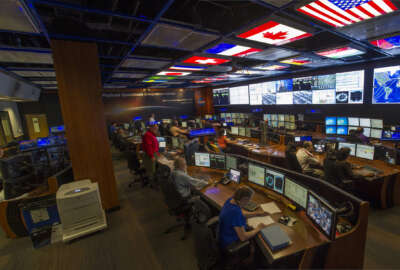NASA might need to change its name to the space and food agency
Agency planners have been thinking hard about how you feed people on long missions, say a year to get to Mars. With the latest on a challenge competition to come up...
Best listening experience is on Chrome, Firefox or Safari. Subscribe to Federal Drive’s daily audio interviews on Apple Podcasts or PodcastOne.
You’ve heard the old saying about airline food. Terrible and not enough. That’s not good enough for NASA. Agency planners have been thinking hard about how you feed people on long missions, say a year to get to Mars. With the latest on a challenge competition to come up with new space cuisine, the project manager for NASA’s Centennial Challenges program, Monsi Roman, joined Federal Drive with Tom Temin.
Interview transcript:
Tom Temin: Ms. Roman, good to have you on.
Monsi Roman: Good morning. Thank you so very much for having us.
Tom Temin: Tell us what’s your objective here with these challenges.
Monsi Roman: So the objective is to provide the crew of long duration missions in the future for NASA with food that is not only good, it has to taste good, is nutritious, is sustainable. And even perhaps the crew will have a little bit of fun putting them together. So there’s not packaged food is something that they’re going to be involved in the process. And the variety is also something very important.
Tom Temin: Yes. So long duration could be months or even a couple of years is the envision here, right?
Monsi Roman: So that is correct. It could be a Moon mission where supplies can be coming from Earth fairly quickly. Or it can be a Mars mission where supplies are not available. And in between the Moon and Mars also, it can be at any stage
Tom Temin: Got it. And presumably there won’t be gas stoves burning aboard any kind of a spacecraft, yet you want to get past the age of freeze dried ice cream, I’m thinking.
Monsi Roman: That is correct. If you have ever tasted that freeze dry ice cream, it’s horrendous. So nobody seems to like it. It’s an experience, something everybody should experience, but it’s terrible. So absolutely something that will provide a variety of food options.
Tom Temin: Yeah, no mouthfuls of Creemore. Alright, so let’s talk about the competition. What is it you are seeking and who are you seeking it from?
Monsi Roman: So when we were putting this together, we wanted to incentivize as many people in the public, not only within the US, but outside of the US to provide us alternatives for food that might taste good, that might be easy, or at least easier to grow or to manufacture in the surface of a planet or on a vehicle on our way to a planet or on the Moon. So what we’re doing is looking for alternatives to what we currently have that can provide a variety of options, like a living pantry, so the crew could go to a living pantry and then choose what boxes they want to turn on. And that will mean that will be their menu for the next week or month, however long it takes to get it ready.
Tom Temin: And you have made 18 initial grants to companies and outfits and nonprofits. Well, you tell me what types of outfits are the recipients of the first round here?
Monsi Roman: So we have a good amount of, we have universities, we have industry, we have starters, we have individuals in the public. One good thing about this competition is everybody likes to eat right, or at least has to eat. So everybody can participate in this competition, right, as long as the frame of mind is consistent with the hardships of actual space mission, right. So in this one, we have 18 top scorers, but we have, and something to understand, those will get money from NASA to continue their development. But the ones that didn’t make it in the top 18, we have really good ones too. So they will be incentivized to continue and hopefully demonstrate that what they are proposing is good. So not only those 18 are important to us, but the rest of the competitors are also important to us. They have really cool ideas.
Tom Temin: And how do you visualize food for astronauts or travelers for this long duration? That is to say, I mean, there’s the MRE concept in the military where all the elements of a standard meal come in this box. And it’s heated up and there’s everything from candy to whatever main dish, dessert and so forth. How do you envision what it is that is consumed up in space?
Monsi Roman: So currently there’s a lot of that going on in missions to space only, when there’s a resupply mission to the space station for example, they can have fresh fruits and chocolate and other things like that, right. So we envision, again, a living pantry and place where they can go and choose boxes or alternatives that they can decide what their menu is going to look like, not at pre-assigned menu before they launch necessarily. That might still be a need but something where they have a say in what is it and they have the opportunity to either grow it, and this is not only about plans, it can be about fungi, it can be about fish, it can be about, I mean, 3D printing. The possibilities are incredible.
Tom Temin: We’re speaking with Monsi Roman, she’s a project manager for NASA’s Centennial Challenges program, and we’re talking about future food development for space. So then, as you envision it then there is some participation by the travelers in the growing and also in the meal by meal preparation of the food as opposed to what we saw in Jackie Kennedy in the White House popping a squeeze bag and tasting something.
Monsi Roman: So that’s correct. Having a meal is something that is social, it has psychology too, it’s the smell, it’s the texture, it’s there aestetic, the green growing things, all those. It is just so many things that need to be considered when you’re talking about food that we don’t realize when we eat our food here, because we take it for granted. But in space, that’s not happening. So that’s where we want to get to where there’s a complete experience, it’s saf, and there’s variety, it is nutritious, and it maintains them healthy.
Tom Temin: You want to grow your own fungi, but not have everything else turn into fungi while it’s sitting up there.
Monsi Roman: As a microbiologist, I agree with you, that is not a good thing.
Tom Temin: And the implication of this challenge program, then is that the standard food industry, which is a really big industry in the United States and worldwide, and they’re pretty good at packaging things for long term, milk packages, but may not be up to the task for all the requirements of space, given the very long duration, the weight consideration, etc, etc.
Monsi Roman: So you just hit on something that is extremely important. The weight conisderation is super important to us too, right. So you don’t want to take everything with you, not only because of how much it weighs, but also because the vitamins and things that your need for nutrition also degrades over time. So you want to because they’re exposed to radiation, there’s other other factors in there too. So there’s nothing better than to be able to go and have options to what you’re eating. And when we’re talking about this little boxes in this living pantry, this can apply also to places on Earth where people might want to do this to, so at their houses they might be able to grow things or have options that they might not have otherwise, even on Earth.
Tom Temin: Sure, even in the back of that tiny air stream kitchen, they might want to do that, and no cans of asparagus than going up into space, I suppose. And from the current crop of 18 of the next round of people that would get funded for the next round, anything in particular that struck you as particularly innovative?
Monsi Roman: We had amazing options in there. Again, talking about fungi, there’s something about fungi in there, there’s something about making bread, there’s this thing about the smell of bread, and right now they use alternatives, but perhaps being able to bake a little piece of bread. There’s alternative to fruits, they use of tissue engineering or tissue growth to actually grow the parts of fruits that will have the taste and the smell and the experience. And all of these will be made in a way that will be sustainable, which is super important to us. So nothing, there’s not going to be a trash generation that is going to go to the trash, literally, we’re incentivizing people to think the whole cycle of the food box.
Tom Temin: And as people would develop, say, as you mentioned tissue in space, or the edible parts of this or that. There’s got to be the factor of palatability I imagine too?
Monsi Roman: Absolutely, and perhaps the definition of now a Mars kitchen or kitchen in space, which will be very different to what a kitchen on Earth will look like, right. So you might have incubators to grow your food as part of your kitchen equipment. And perhaps in the future that’s how it was gonna be, some of those things might have applicability here on Earth too. So there’s there’s a lot of really good stuff to be looking at.
Tom Temin: And what happens next with the 18 awardees?
Monsi Roman: We have an award celebration event in November where we’re going to celebrate them, and then we are expecting to open the next phase of the competition, which will start the process of the teams, all the teams, not only the 18, but all the teams that want to come and demonstrate that they can do what they say they can do. And that starts with the first process of phase two level one ,and we are expecting to open that next calendar year.
Tom Temin: Monsi Roman is a project manager for NASA’s Centennial Challenges Program. Thanks so much for joining me.
Monsi Roman: Thank you so very much for the opportunity to share with everybody what we’re doing, and it’s exciting and we want anybody interested in participating, please look into the phase two dude, because anybody can come in brand new and be part of it.
Tom Temin: And you can look in the glove box of that old Pinto and see what might be growing and send it in.
Monsi Roman: Yes.
Copyright © 2025 Federal News Network. All rights reserved. This website is not intended for users located within the European Economic Area.
Tom Temin is host of the Federal Drive and has been providing insight on federal technology and management issues for more than 30 years.
Follow @tteminWFED






